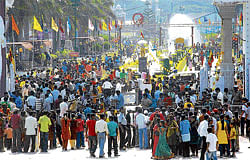When the then Maharaja of Mysore Chamaraja Wodeyar X started the tradition of the

Dasara exhibition in 1880, little did he know that it would later become an integral part of the festivities.
What started with the sole aim of introducing timely developments in the areas of industry and agriculture to the people of Mysore, has now become a major crowdpuller, especially after the Karnataka Exhibition Authority (KEA) was entrusted with the task of holding the Dasara exhibition. The KEA has been adding new attractions in the form of popular tourist spots, albeit temporarily.
The exhibition that is underway has a replica of the Taj Mahal which has become the cynosure of all eyes. The exhibition, which is being held for a month now, is a highly popular one. The credit goes to Velu and his team of artistes from Chennai who have replicated one of the seven wonders of the world, with finesse, at an estimated cost of Rs 65 lakh. The entry fee is fixed at Rs 30 for adults and Rs 20 for children.
In the previous two years, visitors had the rare opportunity to go on a religious sojourn at the replica of Vaishnodevi and Amarnath yatra at the expo.
Apart from ensuring that entry for school children was free on Children’s Day, the organisers also distributed 3,000 biscuit packets, 2,000 chocolates and 7,000 packets of butter milk. It was first brought into effect by the then chief executive officer A B Ibrahim.
History
Jeevannarayana Katte (now J K Grounds) set the platform for the exhibition in its nascent days. It was later shifted to the Mysore Medical College (now Mysore Medical College and Research Institute) premises. Many can still see the closed shutters in MMC and RI building on Irwin road.
The president of the Cultural and Industries Exhibition Committee held the reins of the exhibition from 1976 to 1980 before the Department of Industries and Commerce which conducted the exhibition from 1980 to 1986. Taking account of its increasing popularity, the government decided to form a separate body to look into its affairs and that was how the Karnataka Exhibition Authority (KEA) came into existence in 1981.
But, they had to wait till 1987 to take over the task of the expo. From 1987 to 1993 the exhibition was conducted under the banner of Information, Tourism and Youth Affairs Departments, and from 1994 to 2003 by Kannada and Culture, Information and Tourism Departments. During that period, the state government leased out 80 acres of the total 164 acres of Doddakere Maidana to the authority for a period of 30 years starting from 1996 to host the exhibition.
Since then, Doddakere Maidana comes alive especially during Dasara for a period of 60 days to 80 days and 45 days during summer with ‘Besige Mela’.
It wouldn’t be an exaggeration to say, that if not for the exhibition, the people of Mysore wouldn’t have got a glimpse of the art and culture of different parts of the state, apart from other states. Traders from Tamil Nadu, Andhra Pradesh, New Delhi, Haryana and other states put up stalls here selling garments, grocery items, mats and toys among several other products. A lot of interesting snacks are also available at the exhibition.
From the locally popular chaat items to ‘delhi papad’ visitors are treated to a varied platter. There was a time when cotton candy made out of pink sugar in the form of thin threads drew people young and old alike in large numbers. Needless to say, now, ’gobi manchurian’ and other Chinese dishes top the order, while ‘churmuri’ (made of puffed rice) is still a major attraction.
Chief Executive Officer of KEA M V Hemanth Kumar told Spectrum that a total of 45 stalls are available in ‘A’ block, measuring 10 feet in width and 12 feet long, 20 in ‘B’ block and 46 in ‘C’ block.
Two Rangamandiras (auditoria for programmes) have been constructed at the exhibition premises to conduct cultural programmes.
B V Karanth Rangamandira has four green rooms, and a seating capacity of 2,000 people. P Kalingarao Rangamandira has two green rooms. Separate area has been earmarked for Zilla Panchayats and other departments to open their stalls.
For amusement alone, a total of two acres of area at the southern part of the exhibition is reserved with ‘giant wheels’, ‘Columbus’, ‘toy train’ among others enhancing the mood.
The other attractions include a four-compartment sky track mono rail installed at the cost of Rs 25 lakh at the centre of the exhibition.
The exhibition saw its heydays during the reign of Nalwadi Krishnaraja Wodeyar (1902 to 1940), continued by Jayachamaraja Wodeyar from 1940 to 1947. Though the exhibition now is a government programme, it still retains its charm.